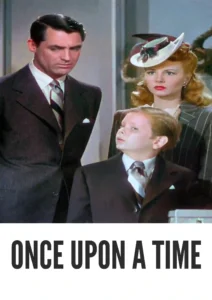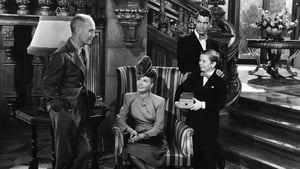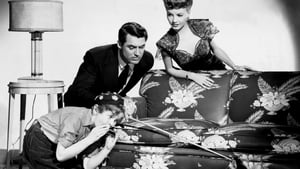Contact: [email protected]
Video Sources 0 Views
- Watch trailer
- Once Upon a Time


Synopsis
Table of Contents
ToggleReview: Once Upon a Time (1944) – A Charming Fairy Tale Romance

Introduction
Once Upon a Time, released in 1944, is a delightful fairy tale romance directed by Alexander Hall. With its whimsical charm, enchanting storyline, and captivating performances, this classic film continues to captivate audiences with its timeless appeal. In this review, we’ll explore the magical world of Once Upon a Time and its enduring legacy in the realm of romantic cinema.
Check The Full Colorized Movies List
Check Our Colorized Movies Trailer Channel
Understanding Once Upon a Time (1944): Director, Cast, and Genre
Directed by Alexander Hall, Once Upon a Time features a talented cast led by Cary Grant and Janet Blair. The film belongs to the romantic fantasy genre, known for its whimsical storytelling, larger-than-life characters, and heartwarming themes.
Exploring the World of Once Upon a Time (1944): Plot and Characters
Once Upon a Time follows the enchanting tale of a humble shoemaker named Joe (Cary Grant) who discovers a magical kingdom hidden within his own shop. With the help of his newfound friends, including a mischievous elf named Felix (Edward Everett Horton) and a beautiful princess named Sylvia (Janet Blair), Joe embarks on a fantastical journey to rescue the kingdom from an evil sorcerer. Along the way, he discovers the true power of love and friendship, proving that even the most ordinary among us can achieve extraordinary feats.
The Art of Film Colorization
While Once Upon a Time was originally filmed in black and white, its early colorized version adds a new layer of enchantment to its magical world. The colorization process enhances the film’s whimsical visuals and brings its fantastical characters to life with vibrant hues and shades.
Early Colored Films: A Brief History
The history of early colored films is marked by innovation and creativity as filmmakers sought to bring their stories to life with vibrant visuals and immersive storytelling. From hand-painted frames to groundbreaking technicolor processes, the evolution of colorization techniques transformed the cinematic landscape, offering audiences a new way to experience the magic of the silver screen.
Once Upon a Time (1944) and Its Early Colored Version
The decision to release Once Upon a Time in a colorized format was made with the intention of immersing audiences in the magical world of the film and enhancing its visual appeal. While some purists may prefer the original black and white version, the early colorized edition of Once Upon a Time adds a new layer of enchantment to its whimsical storytelling and brings its fantastical characters to life with stunning clarity.
The Debate Over Film Colorization
The debate over film colorization continues to spark discussion and controversy within the film community. While some argue that colorization breathes new life into classic films and makes them more accessible to modern audiences, others maintain that it compromises the artistic integrity of the original work. As technology advances and filmmaking techniques evolve, the debate over colorization remains a topic of ongoing debate among cinephiles and industry professionals alike.
Examining Once Upon a Time (1944) as an Early Colored Film
Viewing Once Upon a Time in its early colorized iteration offers audiences a fresh perspective on its magical world and whimsical characters. The colorization process enhances the film’s fantastical visuals and brings its enchanting story to life with vibrant hues and shades. As viewers are transported to the kingdom of the shoemaker, they are treated to a visual feast that immerses them in the wonder and magic of fairy tales.
Influence and Legacy: Once Upon a Time (1944)’s Impact on Cinema
Once Upon a Time is widely regarded as a classic of the romantic fantasy genre that continues to enchant audiences with its timeless storytelling and heartfelt themes. Its whimsical charm, captivating performances, and magical world-building have left an indelible mark on cinema, inspiring countless adaptations and reimaginings in the years since its release.
Director’s Cinematic Legacy: Beyond Once Upon a Time (1944)
Alexander Hall’s directorial legacy extends far beyond Once Upon a Time, encompassing a diverse body of work that includes acclaimed films such as Here Comes Mr. Jordan and My Sister Eileen. As one of the most versatile filmmakers of his generation, Hall was known for his ability to craft engaging narratives that resonated with audiences of all ages. Once Upon a Time stands as a testament to his talent and creativity, solidifying his reputation as a master storyteller in the realm of romantic cinema.
Themes Explored in Once Upon a Time (1944)
At its core, Once Upon a Time explores themes of love, friendship, and the power of imagination in the face of adversity. Through its whimsical storytelling and fantastical characters, the film celebrates the magic of the human spirit and reminds viewers of the importance of believing in the impossible.
Reception and Controversy Surrounding Once Upon a Time (1944)
Upon its release, Once Upon a Time received widespread critical acclaim for its enchanting story, charming performances, and imaginative visuals. While the decision to release the film in a colorized format sparked debate among purists, its enduring popularity has cemented its status as a beloved classic of the romantic fantasy genre.
Where to Watch Once Upon a Time (1944) Online
For those eager to experience Once Upon a Time for themselves, the film is readily available on popular streaming platforms such as Amazon Prime Video, Google Play Movies, and iTunes. Whether viewed in its original black and white format or its early colorized iteration, Once Upon a Time offers a cinematic experience that is both magical and heartwarming.
FAQs About Once Upon a Time (1944)
1. Is Once Upon a Time based on a true story?
No, Once Upon a Time is a fictional film that tells the whimsical tale of a humble shoemaker who discovers a magical kingdom hidden within his own shop. While the film’s storyline may draw inspiration from traditional fairy tales, its characters and plot are works of fiction.
2. Who starred in Once Upon a Time?
Once Upon a Time stars Cary Grant in the role of Joe, the humble shoemaker who embarks on a fantastical journey to rescue a magical kingdom. He is supported by a talented ensemble cast, including Janet Blair, Edward Everett Horton, and James Gleason.
3. What is the central message of Once Upon a Time?
At its core, Once Upon a Time celebrates the power of love, friendship, and imagination in overcoming adversity. Through its whimsical storytelling and fantastical characters, the film reminds viewers of the importance of believing in the impossible and never losing sight of the magic that exists within us all.
4. Why was Once Upon a Time released in a colorized format?
The decision to release Once Upon a Time in a colorized format was made with the intention of immersing audiences in the magical world of the film and enhancing its visual appeal. While some purists may prefer the original black and white version, the early colorized edition of Once Upon a Time adds a new layer of enchantment to its whimsical storytelling and brings its fantastical characters to life with stunning clarity.
5. What is the legacy of Once Upon a Time?
Once Upon a Time is widely regarded as a classic of the romantic fantasy genre that continues to enchant audiences with its timeless storytelling and heartfelt themes. Its whimsical charm, captivating performances, and magical world-building have left an indelible mark on cinema, inspiring countless adaptations and reimaginings in the years since its release.
6. Are there any sequels or remakes of Once Upon a Time?
No, there have been no official sequels or remakes of Once Upon a Time. However, the film’s enduring popularity has inspired countless adaptations and reimaginings in various media. Nonetheless, none have captured the whimsical charm and enchanting spirit of the original 1944 classic.
7. Where can I watch Once Upon a Time online?
For those eager to experience Once Upon a Time for themselves, the film is readily available on popular streaming platforms such as Amazon Prime Video, Google Play Movies, and iTunes. Whether viewed in its original black and white format or its early colorized iteration, Once Upon a Time offers a cinematic experience that is both magical and heartwarming.
Conclusion
In conclusion, Once Upon a Time (1944) stands as a timeless classic of the romantic fantasy genre that continues to enchant audiences with its whimsical storytelling, captivating performances, and imaginative visuals. Whether viewed in its original black and white format or its early colorized iteration, Alexander Hall’s charming direction and the stellar performances of the cast offer a cinematic experience that is both magical and heartwarming. As viewers are transported to the kingdom of the shoemaker, they are treated to a visual feast that celebrates the power of love, friendship, and imagination in overcoming adversity. Once Upon a Time remains a beloved classic that continues to inspire and delight audiences of all ages.












